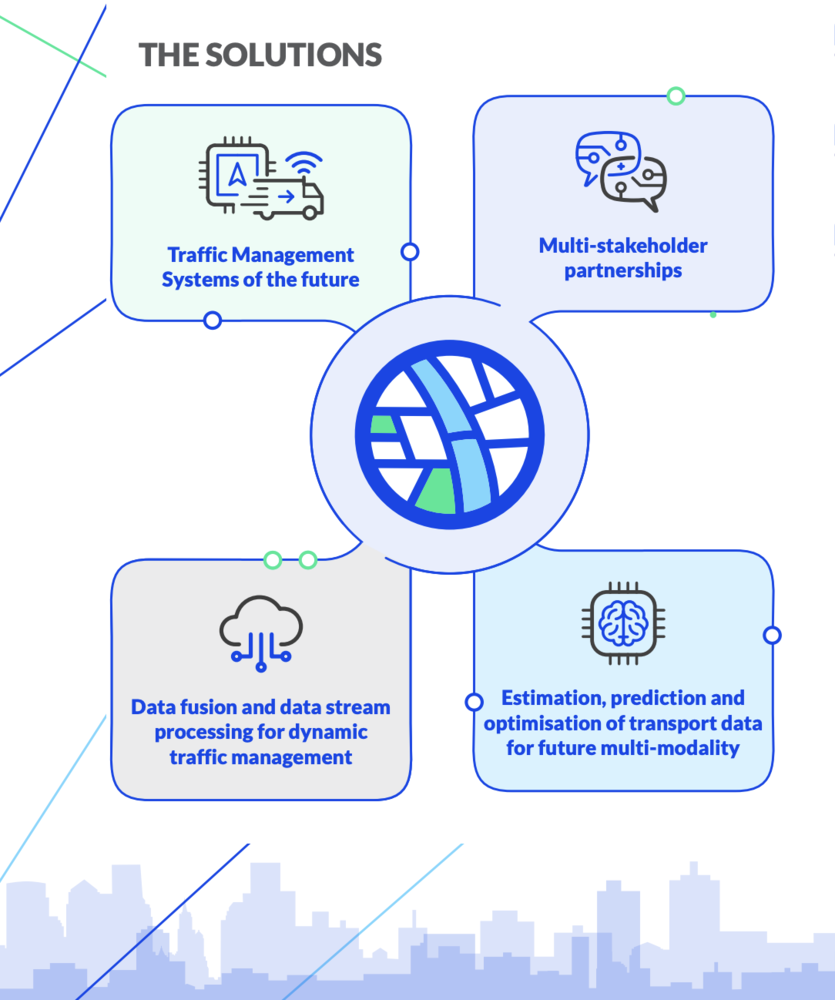- Solutions
- Innovation
- Software
Get Aimsun Next
Use Aimsun Next
About Aimsun Next
- About
Data alone is not enough

Mónica Domínguez
Scientific Researcher
Data-driven solutions can seem like a quick and affordable panacea for transport management problems, but Mónica Domínguez Bajo, PhD (scientific researcher at Aimsun) argues that they offer the greatest value as part of an integrated, common strategy. The FRONTIER research project uses simulation, data analysis and prediction to test cooperative traffic management solutions in various cities across Europe.
The ‘data fever’ of the last few decades has undeniably led to great advances in the field of machine learning and artificial intelligence. We’ve seen a paradigm shift from automating processes to extracting insights from data—usually very large amounts of data. One might even say, twisting a well-known song’s lyrics, “Data makes the world go round”. The transport modeling sector has been no exception to this trend, and we have seen a marked shift to data-driven (and hybrid) solutions. Some artificial intelligence experts seem to be convinced that once we successfully extract knowledge from data, we will possess the magic wand that solves all our problems. But to what extent is this true, especially for transport management?
The paradigm must shift from individual to community-aware solutions
Let’s take a typical example: it’s 8:07 a.m. in the traffic control center of a big city. The main screen shows an alert for unusual congestion starting to occur in a section of a heavily used road heading into the city center. A patrol is sent to the affected area, sees that a broken-down truck is blocking a whole lane of traffic, and takes action. An event that could have caused long queues for the whole morning has been cut down to just half an hour, thanks to the team and the timely automatic alert raised by the incident detection data-driven component. A happy ending, right? But the story doesn’t end there. Taxi drivers stuck in the traffic jam had communicated the incident via their internal platform, causing fewer taxis to decide to go the airport. Because there were fewer taxis, various travelers heading to the airport shifted to public transport, but the frequency of trains and buses wasn’t sufficient to cope with the sudden extra demand and the travelers were subjected to queues and delays. To cut a long story short, what was perceived as a successful intervention in the traffic control center ended up affecting other areas and users of the city’s transport network.
The moral of this story is quite straightforward: a single data-driven model will rarely be enough to solve a complex situation that involves multiple interconnected decisions from different actors, such as the ones we face in traffic management. What is more, each actor in this story may use different data-driven technologies to cope with their specific problems. What is missing is a common strategy to orchestrate the most efficient solution. Information exchange between traffic stakeholders is instrumental in providing an overall picture of the network and not a partial vision of a specific problem.
Information exchange between traffic stakeholders is instrumental in providing an overall picture of the network and not a partial vision of a specific problem.
To facilitate such an exchange of data, strategies and decisions is the main goal of the H2020 EU project known as FRONTIER.

FRONTIER is a three-year project that started in May 2021 with the aim of developing, applying, and testing autonomous management systems. These management systems will constantly evolve using data generated from real-time monitoring of the transportation system, knowledge generated by operators and decision makers, and simulation models providing system optimal solutions accounting for new mobility services and technologies.
Nineteen partners, including Aimsun, jointly research and develop a platform that aims to bridge the gap between data processing and decision making in complex mobility scenarios involving different key stakeholders.

Cooperation and communication in FRONTIER are based on factual data (AKA key performance indicators or KPIs) derived from simulation, data analysis and prediction within what we are calling the Autonomous Network and Traffic Management Engine platform. Stakeholders from Athens, Antwerp and Oxford will be testing specific cooperative strategies for more efficient global mobility at different levels, including future scenarios with autonomous cars. The consortium consists of a multidisciplinary high-profile team including five universities and research institutes, seven companies, and five transport authorities from several European countries: a perfect testbed for data-driven cooperative traffic management solutions.
In a world of eight billion inhabitants, future mobility technologies need to adapt to handling vast data flows and enhancing collaboration across different actors – the paradigm must shift from individual to community-aware solutions. Consequently, the challenge has ceased to be only a technological data-centric one – the emphasis should now be on multidisciplinary teams using technological advances (including data and artificial intelligence, of course) to communicate efficiently and to look ahead towards a common goal.
Further Reading
For more information and updates on the FRONTIER project, you can visit its webpagehttp://frontier-project.eu and subscribe to the project Newsletter (https://frontier.m-pages.com/8tH8hi/frontier-newsletter-subscription-form).
References
References for minds that are curious about data science and artificial intelligence:
• https://www.ai.nl/knowledge-base/what-is-data/
• https://hbr.org/2018/07/collaborative-intelligence-humans-and-ai-are-joining-forces
• Corea, F. (2019) An Introduction to Data: Everything You Need to Know about AI, Big Data and Data Science. Springer: Studies in Big Data.

